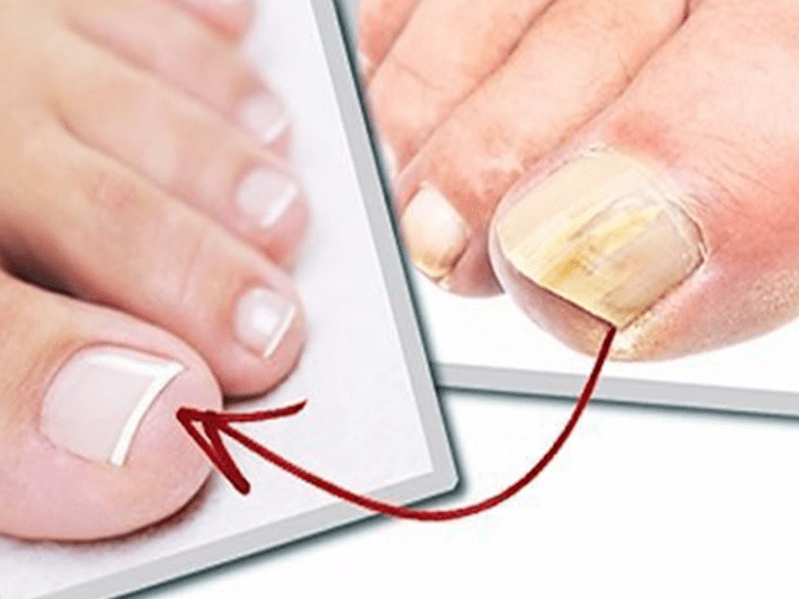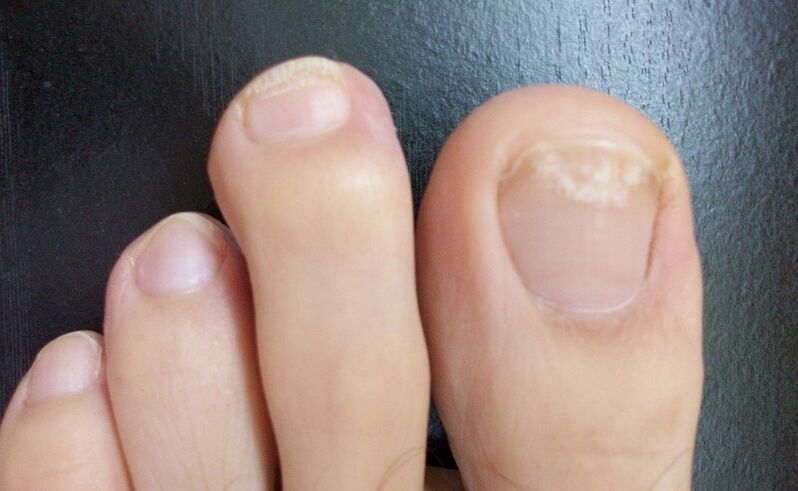
Fungal diseases of the toenails (onychomycosis) are quite common. This disease is contagious in nature and is caused by pathogenic bacteria (epidermophytes). Almost from the moment of infection, a person begins to feel severe itching in the area of \u200b\u200bthe fingers, which even proven methods do not help to cope with. The disease is difficult to treat, so you need to be patient and make a decisionHow to properly treat toenail fungus.
Every fifth person in the world gets a fungus at least once, so it is not difficult to determine its presence by external signs.
Why is the mushroom dangerous?
Fungus on the nails should not be ignored, because this disease is contagious and can disrupt the life of the patient and those around him.
In addition to the desire to scratch the affected area, the nail plates begin to change their structure, peel off, infecting the entire surrounding area with fungus. It's unpleasant to look at, so you can't ignore the wound. In addition, it will not be possible to forget about it, because it will constantly remind itself with itching.
Currently, people are very reluctant to go to the clinic, so the question is always relevant: how to treat nail fungus at home?
Treatment of nail fungus with folk remedies is becoming common. How to treat nail fungus at home?
People are used to thinking that fungus is not a serious disease and that they can get rid of it on their own. Only when they unsuccessfully struggle with the problem for several weeks and see no results, they turn to professionals for help.
During this period, the disease moves to the next stage, the urge to scratch the leg becomes irresistible, causing panic and stress.
You should know that nail fungus visually affects only a separate area of the human body, although in fact it worsens the work of the whole body. Toxins produced during the growth and reproduction of pathogenic fungi settle there.
The blood flow promotes their distribution throughout the body, which leads to disruption of metabolic functions, increases sensitivity to many negative factors, and causes all kinds of complications.
Externally, the affected nail is painted in different colors. It depends on the pathogen, as the fungus can be mold, yeast or dermatophyte.
Over time, keratinization of the nail leads to the fact that even cutting it becomes a problem, and in this case, how to treat nail fungus at home? Traditional methods of treating toenail fungus are the first thing victims turn to.
Causes of fungus:
- open wounds on the legs (scratches, ulcers, scrapes, corns);
- violation of hygiene rules;
- weak immunity;
- antibiotics or other drugs used to treat any disease;
- excessive sweating of the feet.
But all these reasons are secondary, because the main thing is that the infection is still caught in a sick person. About one-third of patients contracted the fungal infection while visiting saunas, swimming pools, nail salons, and other crowded places.
The presence of moisture only activates the infection process and creates favorable conditions for the spread of bacteria. Walking barefoot in a public shower or using someone else's flip-flops for a patient's skin flakes is enough to affect your skin.
You can often get infected by using washcloths, rugs and other similar common items. But even at home, no one is safe from fungal infection.
It is enough for one member of the family to go to the beach or pool and he can become a carrier of bacteria, and if he shares slippers or a sponge with him, the whole family can become infected.
The lack of moisture does not prevent the activity of the fungus. For example, a visit to the fitting room of a store can become a site of infection. People in dressing rooms often take off their shoes and stand on the same mattress.
Shoe stores, where people try to wear shoes without socks, are a real breeding ground for many diseases, including fungal diseases.
Fungal spores can withstand low and high temperatures, which prolongs their life by several months, so that even in the most extreme heat on the beach, they live quietly in the sand.
Given that sand or small pebbles on the beach are a natural scrub for the feet, infected skin particles are found there in abundance and adhere to those with open wounds on the feet.
Second-hand shoes are another carrier of fungal spores. Of course, stores selling such goods are obliged to put them on sale only after undergoing appropriate chemical processing, but this is not always done.
The first manifestations of the fungus

The fungus always manifests itself in different ways. If a person is healthy and there are no injuries on the feet, this can manifest itself in the form of crusting. Symptoms may be more severe if the injury is between the toes or on the heel.
The disease begins with peeling of the skin near the nails, slight redness and itching. This cannot be ignored, because the cause may be uncomfortable or poorly breathing shoes. In addition, redness between the fingers is quite difficult to immediately notice.
Clear signs of fungus are more visible in places where the skin of the feet sweats. Diaper rash appears there, and blisters appear in the later stages.
The color of the nails changes from transparent to yellowish, the plate becomes cloudy and lumpy. When bacteria start to attack the nail, streaks, yellowish spots will appear, the nail will start to crack and peel.
The subungual cavity will be filled with a mixture of scraps and replaced by empty holes. But most of the problems will come from the increased itching and rotten smell, which will be intensified by the sweating of the feet.
The advanced stage may be accompanied by fever and movement problems. In this case, the treatment of fungus on the toes will require urgent medical intervention. It will determine which species cause the disease and what measures should be taken to combat it.
At the initial stage, you can treat nail fungus with folk remedies or using pharmaceutical antifungal ointments and gels.
Options for traditional methods of treating athlete's foot

- The use of washing powder has always been considered effective because it contains alkalis that can kill all types of fungus. Half a cup of powder should be poured into a warm bath and your feet should be immersed in it. You should not sit for more than 15 minutes. The procedure should be repeated within 10 days.
- Everyone knows that garlic kills bacteria. In the fight against fungi, cloves are used in their pure form by cutting them into two parts and soaking them in salt. You don't need to eat garlic, you need to rub it on the area of the foot affected by the fungus. Garlic can cause further irritation and redness, so it should not be applied for long periods of time. 5-7 minutes is enough.
- A compress with ammonia at night is also a method of treating foot fungus with folk remedies. Add a spoonful of ammonia to 250 mg of water, soak a natural cloth that will retain moisture well in the solution and wrap the foot.
- Spread the foot with soda and water paste for 20 minutes. This will stop the spread of bacteria.
- Sprinkle the steamed feet with boric acid powder and put them in socks.
- Does iodine cure nail fungus? Treatment of nail fungus with iodine is not limited to the usual smearing of the affected areas. A product made of iodine, vinegar essence, glycerin and water in a ratio of 1: 2 (2 parts water) helps if you apply it to the affected areas at night. Before that, they should be steamed to open the pores and better penetration of the medicine.
- The simplest method, which can be used only in the first stage of the disease, is to insert tampons soaked in alcohol between your fingers. You can do this overnight or until the alcohol is completely dry.
- Fried onion gruel will also help to stop the spread of infection, for which it should be applied for several hours.
- How to treat foot and nail fungus with herbs? Dry chamomile, mint, sage and nettle are suitable for this purpose. They can be crushed in equal parts, poured into a sock and left overnight. The same powder cannot be used twice, like socks. It is possible to use fresh inflorescences in summer.
- Treatment of foot fungus with vinegar is very effective. How to treat nail fungus with vinegar? For this, it is necessary to take baths with 9% vinegar solution. First, you need to steam your feet, then pour vinegar into warm water, lower your feet there for 15 minutes so that the soles of your feet do not touch the bottom. After the procedure, allow your feet to dry naturally without washing them with clean water.
- We treat nail fungus with hydrogen peroxide. The application process is the same as in the case of vinegar, only 3% peroxide is used instead.
- Cut a lemon into slices and apply it on the affected nail. Cover with gauze and wrap with film overnight.
Prevention

To effectively treat toenail fungus, it is best to prevent the infection in the first place. To get rid of an unpleasant disease, you should follow the recommendations:
- do not walk barefoot in public places;
- when visiting the gym, swimming pool, water park, wear rubber slippers;
- use an antifungal varnish with a fungicidal effect;
- buy comfortable shoes made of cloth or leather;
- make sure that in nail salons they work with you only with tools that have undergone heat treatment;
- do not use a stranger's slippers, towels or socks;
- don't wear the same socks every day;
- wash your feet in the morning and evening;
- take vitamins;
- At the first signs of fungal disease, use a gel that eliminates itching, peeling and erosion.
What is dangerous and how to treat developed nail fungus at home
An old fungus can aggravate diseases such as diabetes, bronchial asthma or allergies. It becomes a channel for other infections that can affect the internal organs.
An increase in the amount of toxins in the body causes intoxication.
An old fungus cannot be treated only with folk remedies. How to treat advanced nail fungus? For this, a course of medication under the supervision of a dermatologist will be required, and folk remedies should be used in addition.
The causes of advanced fungus can be a late visit to the doctor, an incorrectly prescribed course of treatment or the ineffectiveness of the drugs used.
Old fungus requires long-term treatment, which can last six months. How to treat old nail fungus?
The doctor can make a diagnosis only after analyzing scraps from the damaged area, after which he will prescribe antifungal drugs. Be careful with some medications, they are contraindicated during pregnancy.
In parallel with tablets, creams and ointments applied to the lesion are used.
How to treat advanced nail fungus with folk remedies
- Cotton swabs are soaked in propolis tincture with 20% alcohol and applied to damaged nails. Propolis helps to quickly destroy the fungus, after which the old nail plate falls off and a healthy one grows again.
- Kombucha gruel applied to the affected area helps fight the fungus. It is applied daily for several hours.
- An ointment consisting of 100 grams of butter, shelled eggs and 50 mg of 70% acetic acid is used daily. All ingredients are placed in a jar and not mixed. The ointment should be kept in the refrigerator for a week until the crusts are completely dissolved. After that, the ingredients can be mixed until smooth.
- 15 grams of calamus root is poured with boiling water and left for 30 minutes. The infusion should be drunk 4 times a quarter cup.
- At night, you need to apply ointment with 1/2 teaspoon of the ashes of 3 cigarettes on your nails. fluoride toothpaste.

What is the best way to treat nail fungus? There are many effective remedies, but they can be used according to the stage of the disease.
Early stages can be treated with folk remedies, for older stages, complex treatment with drugs should be used in combination with home medicine methods.
















